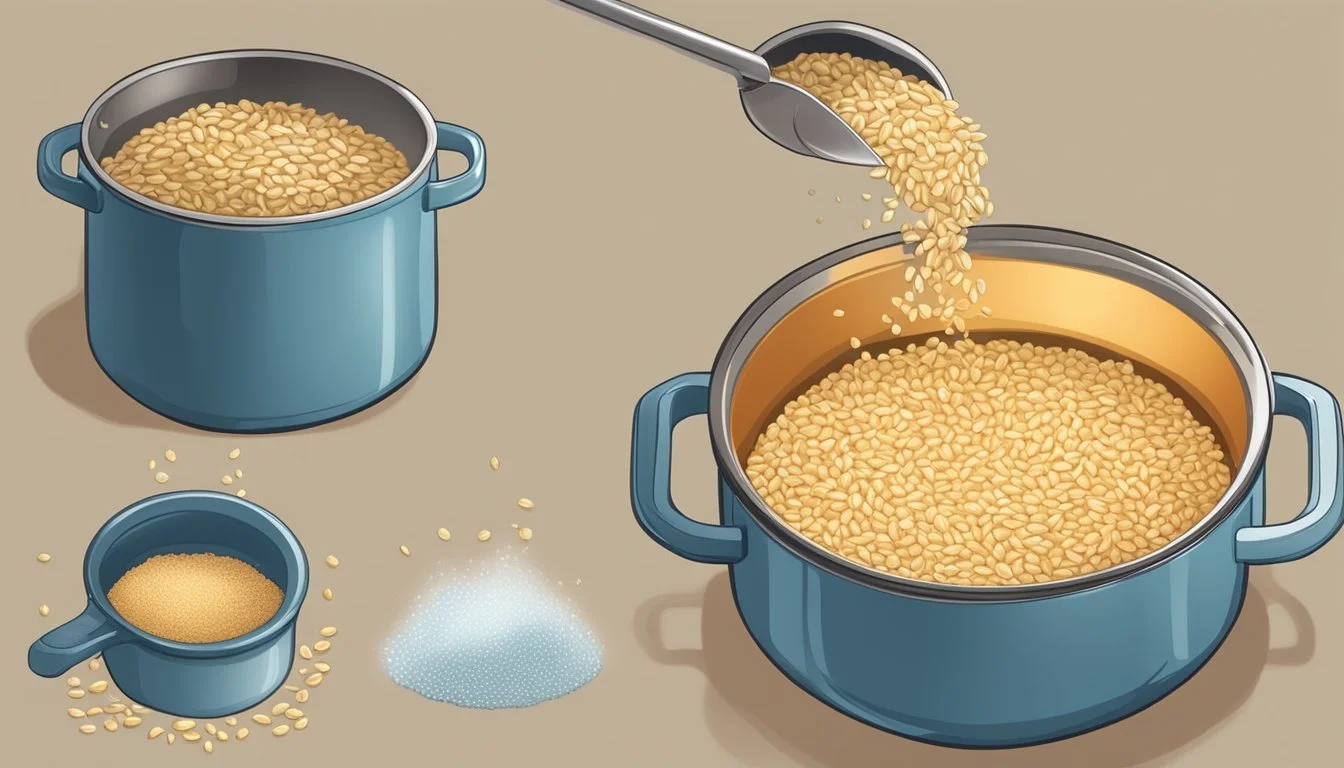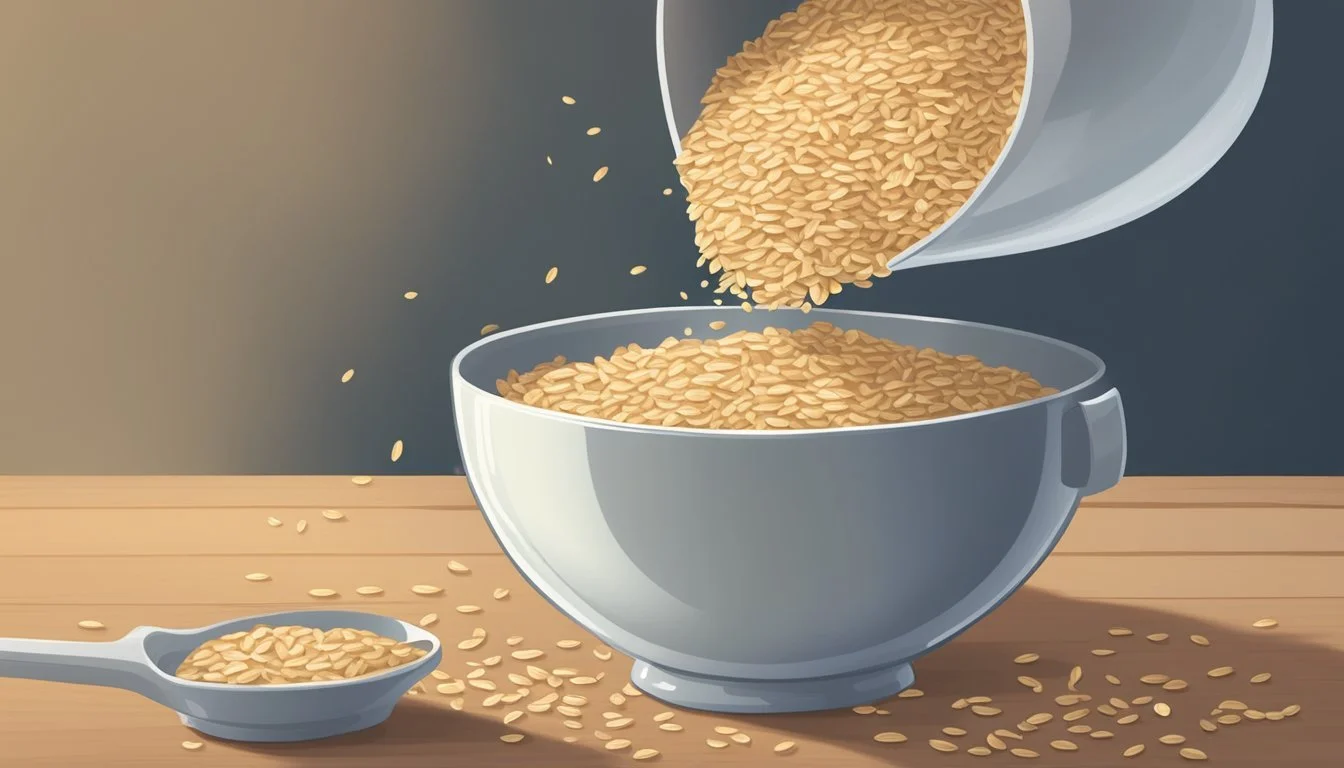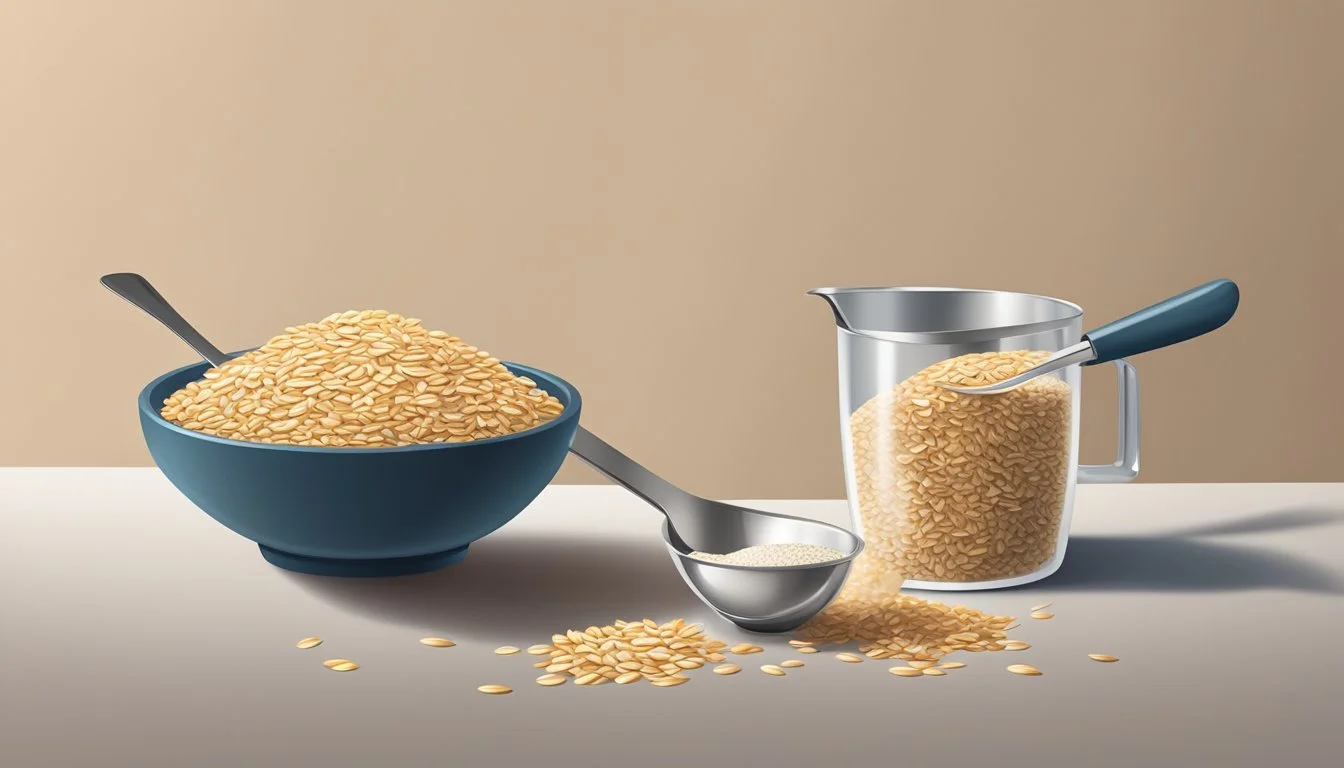How to Substitute Oat Groats for Steel-Cut Oats
A Step-by-Step Guide
Oat groats and steel-cut oats are versatile grains that have become staples for those looking for healthy and hearty breakfast options. Oat groats are the whole oat kernel with only the inedible husk removed, offering a chewy texture and a pure grain flavor. Steel-cut oats, on the other hand, are made from oat groats that have been chopped into smaller pieces, which results in a reduced cooking time compared to whole oat groats. Though different in form and preparation time, with the right approach, these whole grains can be used interchangeably in various recipes.
In the kitchen, understanding how to substitute oat groats for steel-cut oats can expand culinary options and offer flexibility in meal planning. Since oat groats take longer to cook, an adjustment in preparation methods and cooking times is necessary when making a substitute. For those looking to replace steel-cut oats with oat groats, an awareness of texture and taste outcomes is also crucial. The substitution usually requires a greater volume of water and a longer cooking duration to achieve a similar consistency to that of steel-cut oats.
The transition from steel-cut oats to oat groats in a recipe can be seamless when following a few general guidelines. A good starting point is to soak oat groats overnight to soften them, which greatly reduces the cooking time and results in a creamy consistency more akin to steel-cut oats. Considering the liquid-to-groat ratio and the desired end texture when adjusting the recipe is also important. Typically, one would use a three-to-one liquid-to-groat ratio and cook them for an extended period, often with methods such as simmering on the stove or using a slow cooker. With these considerations, oat groats can successfully be substituted for steel-cut oats in a variety of dishes, from traditional breakfast porridges to savory stuffings.
Understanding Oats
When considering oat substitutions, it's crucial to understand the differences in oat varieties, how they are processed, and their nutritional profiles.
Types of Oats
Oats are a grain harvested from the oat plant and they come in various forms, each with distinct characteristics:
Oat Groats: The whole oat kernel with the husk removed. They retain most of their nutrients and have a hearty, chewy texture.
Steel-Cut Oats: Also known as Irish or Scottish oats, these are oat groats cut into two or three pieces with a steel blade, offering a dense and chewy texture.
Rolled Oats: Oat groats that are steamed and then flattened with rollers. They are quicker to cook than steel-cut oats and have a milder flavor and softer texture.
Oat Processing Methods
The processing method of oats affects their cooking time, texture, and flavor:
Whole Oat Groats: These are minimally processed, which means they take the longest to cook but maintain a firm, chewy consistency.
Steel-Cut Oats: These oats are somewhat processed as they are chopped into pieces, which reduces cooking time but still leaves a textured bite.
Rolled Oats: They undergo further processing, being steamed and flattened, resulting in a quicker cooking time and a soft texture.
Nutritional Comparison
Oats are generally nutritious across all forms, as they are high in fiber, protein, vitamins, and minerals. Here’s how the different types of oats compare nutritionally:
Protein: All oats are a good source of protein, which is key for muscle repair and growth.
Fiber: Oats are high in both soluble and insoluble fiber, beneficial for digestion and heart health.
Vitamins and Minerals: Rich in B vitamins, iron, magnesium, and zinc, oats are nutritionally valuable.
Gluten-Free: While oats are naturally gluten-free, they may be processed in facilities that handle gluten-containing grains, which can lead to cross-contamination.
Type of Oats Protein Fiber Gluten-Free Note Oat Groats High High Usually Whole and unprocessed, maintaining most nutrients Steel-Cut Oats High High Usually Slightly processed, retains most of the grain’s benefits Rolled Oats High High Usually More processed, have a softer texture and cook more quickly
Oats, in all forms, provide good nutritional value and can generally be considered whole grains with benefits for overall health.
Preparation Basics
In substituting oat groats for steel-cut oats, one must consider differences in cooking time, liquid ratios, and appropriate cooking methods to achieve a similar texture and flavor profile.
Soaking and Cooking Time
Oat groats demand a longer cooking time compared to steel-cut oats. To narrow this gap, one can soak the groats overnight which will soften them considerably. This soaking process allows the groats to absorb water, reducing the overall cooking time. After soaking, a typical cooking process for oat groats may take 45 minutes to an hour, whereas soaked steel-cut oats often cook in about 20-30 minutes.
Liquid Ratios for Substitution
When substituting oat groats for steel-cut oats, the liquid ratios play a crucial role. Normally, steel-cut oats use a liquid-to-oat ratio of about 3:1 to 4:1 depending on desired consistency. For oat groats, which require more liquid due to their denser structure, one might need to adjust the ratio to approximately 4:1. However, if groats have been soaked overnight, this ratio might be closer to what is used for steel-cut oats.
Adjusting Cooking Methods
Cooking methods impact the texture of your oatmeal, and adjustments may need to be made when using oat groats. For instance, using a slow cooker can be an excellent way to cook groats without constant supervision. Meanwhile, steel-cut oats are effectively prepared using various appliances including the stovetop, microwave, and an Instant Pot. With groats, one should cook them on a stovetop on a low simmer or in a slow cooker on low heat. Microwave cooking is not usually recommended for groats due to their longer required cook time.
Substituting Oat Groats
When replacing steel-cut oats with oat groats, one must consider measurement, texture, flavor, and cooking time to achieve a desirable result.
Measurement Guidelines
Replace steel-cut oats with oat groats in a 1:1 ratio for most recipes. This simple equivalence ensures maintaining the recipe's balance while substituting the type of oats.
For savory dishes: Replace an equal amount of steel-cut oats with oat groats.
For sweet dishes: Adjust added sugar if necessary, as oat groats may have a slightly different taste.
Texture and Flavor Considerations
Oat groats present a distinctly nutty flavor and a pleasingly chewy texture due to their larger grain size. They differ from the more creamy texture of steel-cut oats and do not become as gelatinous when refrigerated.
Toasting: To mimic the nuttiness of steel-cut oats, toast oat groats before cooking.
Flavor profiles: Bear in mind that the substitution might slightly alter the final flavor profile, enhancing the dish's overall nuttiness.
Cook Time Adjustments
Oat groats typically require longer cooking times than steel-cut oats.
Standard Cooking: Simmer oat groats in water for about 15-20 minutes or until tender.
Liquid Ratio: Use a liquid-to-groat ratio of 2:1 to ensure proper cooking without drying out the grains.
Soaking: Consider soaking oat groats overnight to shorten the cooking time and achieve a texture closer to that of steel-cut oats.
Health Benefits and Dietary Considerations
When considering oat groats as a substitute for steel-cut oats, one should keep in mind their impact on gluten sensitivities, blood sugar levels, and heart health. Both oats offer similar health benefits, such as being high in dietary fiber and various nutrients essential for a balanced diet.
Celiac Disease and Gluten Sensitivities
Oat groats are naturally gluten-free, making them a safe alternative for individuals with celiac disease or gluten sensitivities. However, it is crucial to verify that the oats are processed in a gluten-free facility to prevent cross-contamination. A gluten-free diet incorporating oat groats can provide the necessary fiber without triggering adverse reactions.
Blood Sugar and Glycemic Index
Oat groats have a low glycemic index (GI), which means they have a less significant impact on blood sugar compared to other grains. This lower GI score is beneficial for managing blood sugar levels, which is particularly important for individuals with diabetes. The dietary fiber in oat groats contributes to slow digestion and steadier blood sugar levels.
Heart Health and Cholesterol
High in dietary fiber, oat groats can aid in maintaining heart health by helping to reduce cholesterol levels. The soluble fiber found in oats, specifically beta-glucan, is associated with lower cholesterol levels and thus contributes to a reduced risk of heart disease. Incorporating oat groats in one's diet can be a part of a heart-healthy dietary regimen.
Recipe Applications
When substituting oat groats for steel-cut oats, chefs should consider the texture differences and cooking times. Below are specific applications for using oat groat substitutes in traditional steel-cut oat recipes.
Oatmeal and Porridge Variations
Oat groats need a longer cooking time compared to steel-cut oats, typically requiring a simmer for about 30-40 minutes until they become tender. For a basic oatmeal or porridge, a liquid-to-groat ratio of 3:1 is suggested. One can flavor the porridge with toppings like sliced bananas, honey, or a mixture of seeds for a nutritious and flavorful breakfast.
Recipe Example:
Ingredients:
1 cup oat groats
3 cups water or milk
Pinch of salt
Toppings (honey, seeds, banana slices)
Directions:
Bring water or milk to a boil.
Add oat groats and salt; reduce to a simmer.
Cook for 30-40 minutes, stirring occasionally.
Serve with preferred toppings.
Baking with Oat Groats
For baking, oat groats can be ground into flour and used to create hearty breads or cookies. However, groat flour will be denser than steel-cut oat flour, so it should be mixed with other flours for lighter baked goods. The groats can also be soaked overnight to soften them for use in recipes like muffins or granola bars.
Tips for Baking:
Soak groats overnight to soften for use in baked goods.
Combine groat flour with wheat flour to prevent dense textures.
Savory Dish Adaptations
In savory dishes, oat groats can replace steel-cut oats as a base for pilafs and stuffing, providing a nutty flavor and satisfying chew. Cooking the groats with a broth instead of water can infuse them with a more complex, flavorful profile, especially suitable for dinner recipes.
Instructions for Savory Dishes:
Toast the groats before simmering to heighten the nutty nuances.
Use a 2:1 liquid-to-groat ratio and cook until tender, typically 15-20 minutes.
For pilafs, sauté onions, carrots, or other vegetables before adding the groats and liquid.
Additional Tips and Advice
Substituting oat groats for steel-cut oats can be straightforward, but there are key factors to ensure that the groats retain freshness and flavor. Implementing ideal storage methods, enhancing the dish with nutrient-rich toppings, and understanding alternative grain substitutes will optimize the use of oat groats in any recipe.
Optimal Storage for Freshness
To maximize the shelf life of oat groats, they should be stored in an airtight container in a cool, dry place. If steel blades or other sharp tools were used to process the groats, ensure there are no metallic residues as these can spoil the groats. Oat groats can last up to 30 days when stored properly, maintaining freshness and nutritional quality.
Enhancing Flavor and Nutrition with Toppings
Nuts: A sprinkle of almonds or walnuts adds healthy fats and a satisfying crunch.
Fruits: Fresh or dried fruits contribute natural sweetness and fiber.
Seeds: Chia or flaxseeds provide additional nutrients and texture.
Mixing various toppings into oat groats not only enhances flavor but also boosts the nutritional profile, providing a variety of vitamins and minerals.
Substitutes beyond Oat Groats
For those looking for alternatives to steel-cut oats, consider these grains:
Substitute Cooking Time Flavor Profile Texture Buckwheat 15-20 minutes Nutty Chewy Quinoa 15-20 minutes Mild Soft, Fluffy Millet 25-30 minutes Sweet Light, Dry Amaranth 20-25 minutes Earthy Porridge-like
Each of these grains offers a unique taste and texture while providing similar nutritious benefits to oat groats. It's important to follow specific cooking times and liquid ratios for the best results.
Conclusion
Substituting whole oat groats for steel-cut oats can be managed successfully with a mindful approach towards preparation and cooking. Whole oat groats maintain their integrity better than steel-cut oats, preserving individual grains even after refrigeration. To utilize oat groats as an alternative, consumers should remember the larger size and firmer texture of whole oat kernels, making them distinct from steel-cut oats in texture and cooking time.
The nutritional benefits of incorporating whole oat groats are substantial as they are less processed and contain more soluble fiber and essential nutrients. Their enduring texture also suggests they may be more suitable for dishes requiring refrigeration and reheating.
Here is a concise guide to help:
Preparation
Soak whole oat groats overnight.
Swap at a 1:1 ratio for steel-cut oats.
Cooking Adjustments
For every 1 cup of oat groats, use 3 cups of water.
Cook for approximately 45-60 minutes until the desired tenderness is reached.
Advantages of Oat Groats
Higher in Soluble Fiber: Beneficial for digestive health.
Rich in Essential Nutrients: Preserved due to minimal processing.
In conclusion, when substituting oats, it is important to consider the slight differences in preparation and cooking time. Whole oat groats can stand up well as a substitute for steel-cut oats, with the added advantage of potentially greater nutritional benefits.






